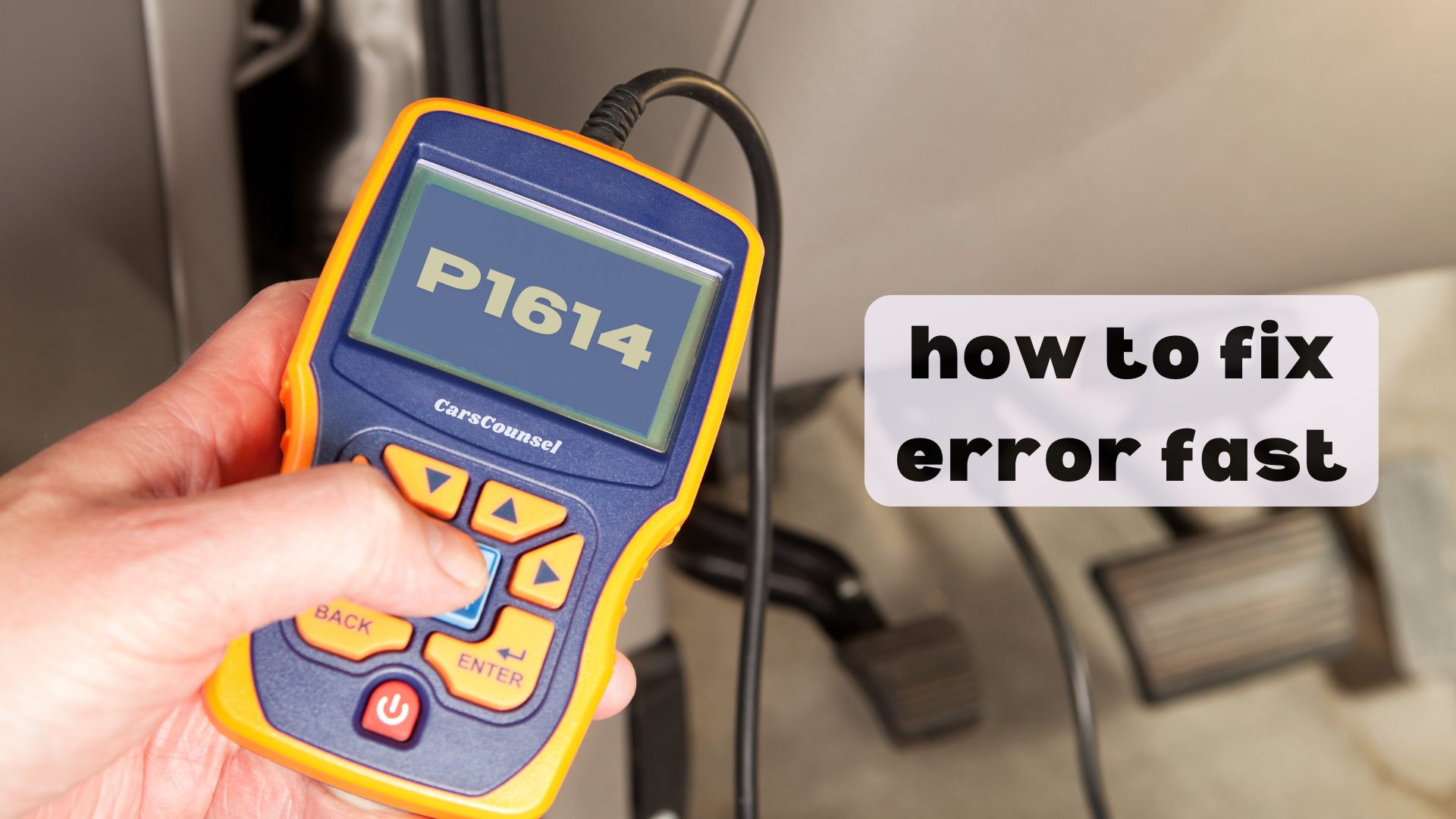Dealing with a P1614 code can be annoying, but fixing it quickly can save you a lot of trouble.
First, use an OBD-II scanner to confirm the trouble code.
Then, check the wiring and connectors for any damage or rust.
If the problem is with the key transponder, you might need to reprogram or replace it.
Also, make sure to inspect the wiring between the immobilizer control module and the engine control module (ECM).
After doing these checks, clear the error codes and take your car for a test drive.
Want to know more about the detailed steps and how to prevent this issue in the future?

Quick Navigation
Key Takeaways
- Use an OBD-II scanner to confirm the P1614 code and find out what’s causing it.
- Check and fix any damaged wires or corroded connectors between the immobilizer and the Engine Control Module (ECM).
- Reprogram or replace any faulty keys and key transponders to make sure they communicate properly.
- Use a multimeter to test the immobilizer control module and ECM for power, ground, and signal issues.
Understanding the P1614 Code
The P1614 code means there’s a problem with the communication between the immobilizer control module and the engine or transmission control modules.
This issue can make it hard to start your vehicle and will usually turn on the Check Engine Light (CEL). The immobilizer is important for preventing theft by ensuring the engine only starts with the right key.
If there’s a communication failure, it can seriously affect how your engine runs. The Engine Control Module (ECM) and Transmission Control Module (TCM) need clear signals to control the engine and transmission properly.
Any problems here can lead to poor engine performance, higher fuel consumption, and might even cause the engine to go into limp mode.
Understanding the P1614 code is important for diagnosing and keeping your vehicle running well.
Symptoms of P1614 Code
If your vehicle shows a P1614 code, you might notice problems like difficulty starting your car, it stalling, or the transmission shifting erratically. These issues point to communication problems between the immobilizer control module and the engine control modules.
Recognizing these symptoms is crucial for keeping your engine running smoothly. You might see the engine cranking but not starting, experience random stalling while driving, or notice the transmission behaving inconsistently. The Check Engine Light (CEL) will also likely come on.
These problems can greatly affect how your car drives and performs. It’s important to address them quickly to avoid more serious issues, like the car going into limp mode, which limits engine power and speed, making driving difficult.
Common Causes
The P1614 code often happens because of problems with the car’s immobilizer system. Common reasons include a broken immobilizer control module, faulty keys, or damaged key transponders.
These key issues can stop the key from talking to the immobilizer correctly, which means the engine won’t start. Sometimes, the immobilizer module itself has software or hardware problems.
Wiring problems between the immobilizer control module and the Engine Control Module (ECM) can also cause this issue. Other factors like extreme temperatures and electromagnetic interference can make these problems worse.
Fixing these issues quickly is important to get the car running again.
Affected Nissan Models
If you have a Nissan Altima (2002-2006) or Sentra (2000-2006), you might run into engine starting problems and stalling because of a common issue with the P1614 code.
This code means there are communication problems between the Engine Control Module (ECM) and the immobilizer control module. These problems can cause poor acceleration and make the engine run erratically.
The Infiniti Q45 can also have this issue, but we’ll talk about that later.
For these Nissan models, it’s important to regularly check the wiring and key transponders.
Fixing these problems quickly can prevent more serious engine damage and keep your car running smoothly.
Affected Infiniti Models
For Infiniti Q45 models from 2002 to 2006, the P1614 code means there’s a communication problem between the immobilizer control module and the engine control module (ECM).
This can cause issues like the engine stalling or not accelerating properly. You might also find that your keyfob won’t start the engine, which can really hurt the car’s reliability.
This code usually comes up because of faulty wiring or damaged connectors that mess with the signal between the keyfob and the immobilizer system.
To fix this, make sure your keyfob is working right and check the connections on the immobilizer control module.
Regular maintenance and quick diagnosis are key to keeping your Infiniti reliable and avoiding more problems.
Using an OBD-II Scanner
To figure out what’s causing the P1614 code in your Infiniti Q45, you’ll need an OBD-II scanner to confirm the code and check for any other related codes.
Make sure your scanner works with your car. Here’s how to do it:
- Connect the Scanner: Plug the scanner into the port under the dashboard.
- Read Codes: Turn on the ignition and use the scanner to read the error codes.
- Analyze Data: Look at the codes and any related information to understand what’s wrong.
Using the right OBD-II scanner helps you accurately diagnose the problem and find the exact cause of the P1614 code, making repairs easier.
Visual Inspection Steps
To do a visual inspection, start by checking all the wires and connectors between the immobilizer control module, ECM, and TCM for any signs of damage or rust.
Carefully look at each wire for cracks, fraying, or discoloration. Be on the lookout for exposed wires, burnt spots, or greenish rust on connectors.
Make sure all connections are tight and clean. Pay extra attention to spots where wires go through engine parts or near heat sources, as these are more likely to get damaged.
If you find any damaged wires or connectors, fix them right away to ensure proper communication between the modules and solve the P1614 code.
Testing Control Modules
Testing control modules means checking if the different parts that control your car’s engine, transmission, and security system are working properly. To do this, you’ll need a multimeter and an OBD-II scanner. Here’s how you can test them:
- Check Power and Ground: Use the multimeter to see if the immobilizer control module is getting the right amount of power. Make sure the readings are within the acceptable range.
- Look for Communication Problems: Use the OBD-II scanner to find any issues with how the engine control module (ECM), transmission control module (TCM), and immobilizer are talking to each other. Check for any error codes.
- Test the Signals: Use the multimeter to make sure the signals on the communication lines are steady and within the normal range.
Repair and Replacement
When dealing with the P1614 code, start by replacing or reprogramming the faulty key to make sure it communicates properly with the immobilizer control module.
Check the key transponder for any damage since that can often cause signal problems. If the key looks fine, reprogram it using a diagnostic tool that works with your system.
If the problem persists, look at the immobilizer module itself. Repair steps include checking and fixing any damaged wires or connectors between the immobilizer and the ECM.
If needed, you might have to replace the immobilizer control module or the ECM.
Always clear the code and take the car for a test drive after repairs to make sure the issue is fixed. This straightforward method ensures a quick and effective solution.
Preventative Measures
Preventative Measures
Regular maintenance and periodic check-ups are essential to prevent the P1614 code from coming back. By keeping up with routine maintenance, you ensure the immobilizer system in your vehicle stays reliable and lasts longer.
Here’s what you should do:
- Check the Wires: Regularly look at the connections between the immobilizer and the ECM/TCM to make sure there are no signs of damage or rust.
- Keep Connectors Clean: Make sure all electrical connectors are clean and securely attached to avoid any communication problems.
- Get Professional Check-Ups: Have a mechanic do regular diagnostics to spot and fix potential issues early on.
More OBD-II Codes
Frequently Asked Questions
How Much Does It Typically Cost to Fix a P1614 Code?
Fixing a P1614 code usually costs between $150 and $400. This price includes the diagnostic fees, which are generally between $50 and $100, along with the cost of parts and labor.
Can the P1614 Code Be Fixed Without Professional Help?
You can try fixing the P1614 code yourself by checking the wiring and connectors. However, programming the key usually needs special tools and know-how that professionals have. To ensure the job is done right, it’s best to consult a professional.
What Tools Are Needed to Diagnose and Repair the P1614 Code?
You might think you can’t do it, but with the right tools and repair guides, you can handle the P1614 code. Use a code reader, a multimeter, and detailed repair guides to diagnose and fix the problem accurately.
How Long Does It Take to Fix the P1614 Code?
To fix the P1614 code, it usually takes about 1-2 hours. This depends on the steps you need to take, which include using an OBD-II scanner to diagnose the issue, checking the wiring, inspecting the modules, and possibly reprogramming the keys.
Can Aftermarket Keys Cause a P1614 Code to Appear?
Did you know that aftermarket keys can cause a P1614 code? If they’re not programmed correctly, they might not communicate with the immobilizer, leading to problems. Make sure the keys are properly programmed to avoid this issue.
Conclusion
Just like a detective solving a case, you’ve learned how to fix the P1614 code.
Start by checking the wiring and connectors thoroughly.
Then, reprogram or replace the key transponder and make sure the immobilizer control module is working properly.
Clear the codes and take a test drive to see if everything is fixed.
Follow these steps, and your car will be back on the road, running smoothly in no time.

